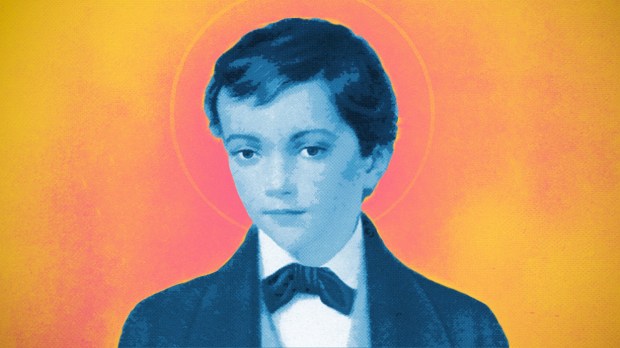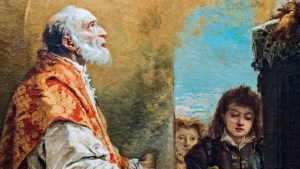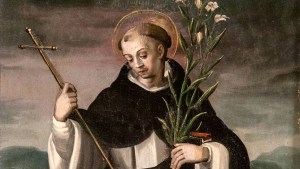Lenten Campaign 2025
This content is free of charge, as are all our articles.
Support us with a donation that is tax-deductible and enable us to continue to reach millions of readers.
St. Dominic Savio was born in Castelnuovo d’Asti, Italy, on April 2, 1842.
His spiritual director was none other than St. John Bosco, also known simply as Don Bosco, who wrote this about the boy:
“[Dominic] has a sweet nature and a heart formed for piety; he learned the morning and evening prayers with extraordinary ease and prayed them when he was only 4 years old.”
At the age of 5, Dominic already impressed everyone by his devotion at Mass, particularly when he helped as an altar boy—although it wasn’t easy for him to hold the large missal in his tiny hands.
His guiding principles
Dominic Savio, although just a child, had a very clear guideline for his life: “Better to die than to sin.”
To be faithful to this principle, he avoided mischievous company and became friends with those who were well behaved. In addition, he went to confession frequently. Dominic was allowed to receive his First Communion at age 7, even though the minimum age was 12. On this occasion, he recorded his impactful personal resolutions:
Resolutions which I, Dominic Savio, set myself in the year 1849, when I made First Communion, at the age of 7:
1 – I will go to Confession very often and receive Holy Communion whenever my confessor allows me;
2 – I want to keep the feast days holy;
3 – My friends will be Jesus and Mary;
4 – I would rather die than sin.
Exemplary at school
The Savio family had moved to Mondonio, 7 miles from Castelnuovo. After Dominic finished primary school, the only option to continue his studies was to go on foot to the neighboring town. The frail 10-year-old boy walked the route to and from Mondonio every day; he needed to study because he wanted to become a priest. Applied and disciplined, Dominic was first in his class.
His classmates once filled a school stove with stones and accused Dominic of this. The schoolmaster doubted the story, but had to reprimand the boy publicly because the supposed evidence pointed to his guilt—and besides, Dominic refused to defend himself. But the truth came out the next day. The schoolmaster then asked why Dominic had not defended his own innocence. The boy answered that he wanted to imitate Jesus, who was unjustly accused and did not defend himself. He also knew that he would be forgiven because it would be considered his first transgression, while his classmates, if they were accused, could suffer expulsion from school.
Making an impression
In 1854, Dominic’s teacher went to see Don Bosco “to speak of a pupil of his who was worthy of particular attention.” Dominic Savio was 12 years old, and Don Bosco describes him thus:
Dominic was frail and delicate of complexion, somber in appearance and at the same time sweet, with something of pleasant seriousness. He was affable and pleasant, always in the same humor. In class and out of it, in church and everywhere else, he always kept such composure that the schoolmaster felt the most pleasant impression just by seeing him and speaking to him (…) All the virtues that we saw sprout and grow in him, in the various stages of life, always increased wonderfully and grew together, without one doing so to the detriment of the other (…). In ordinary things, he began to become extraordinary (…). Here began that most exemplary life, that continuous progress from virtue to virtue, and that exactitude in the fulfillment of his duties that one could hardly surpass.”
Friend of Jesus and Mary
Little Dominic was deeply devoted to Mary. On December 8, 1854, the date and year of the proclamation of the dogma of the Immaculate Conception, he renewed his First Communion resolutions with the following prayer: “Mary, I give you my heart. Make me yours. Jesus and Mary, be always my friends; but, out of love for you, make me die a thousand times before I have the misfortune to commit a single sin.”
Desire for sanctity by always being cheerful
In Don Bosco’s Oratory, Dominic Savio was encouraged to seek sanctity, so he went to see the saint and told him, “I feel the desire and need to be a saint. I had never imagined that one could be a saint so easily! But now that I’ve seen that it is possible if you are always cheerful, I want and absolutely need to be a saint.”
Don Bosco then advised the boy to “win souls for God, for there is nothing more holy in this life than to cooperate with God in the salvation of souls, for which Jesus has shed up to the last drop of his most precious blood.”
A holy teenager
Dominic never missed an opportunity to give good advice, and he was especially concerned about children who, when they reach adolescence, “become morally corrupt and lose their souls, perhaps eternally, because there’s no one to instruct them in the faith!”
On March 9, 1857, at the age of 15, Dominic Savio died in sanctity. Convinced of the future canonization of the young man, Don Bosco wrote about this certainty, saying that there were many “who, having experienced the effects of your heavenly protection, gratefully and eagerly await the word of the infallible oracle of our Holy Mother, the Church.”



